Evaluation of Leadership Theories: Brad Banducci at Woolworths
VerifiedAdded on 2019/11/26
|12
|3175
|117
Report
AI Summary
This report provides a comprehensive overview of various leadership theories, including trait theory, process theory, behavioral aspects, contingency theory, participative/democratic leadership, servant leadership, transformational leadership, transactional leadership, and LMX theory. The report then applies these theories to evaluate the leadership style of Brad Banducci, the CEO of Woolworths. It analyzes Banducci's approach, highlighting his transformational and visionary leadership qualities. The report examines how Banducci has influenced the organizational culture of Woolworths, focusing on his strategic initiatives, including sales growth targets, price adjustments, supply chain improvements, and brand restructuring. The report also assesses change management strategies employed by Banducci, concluding with an evaluation of his overall leadership effectiveness within the context of Woolworths' operations and market position.
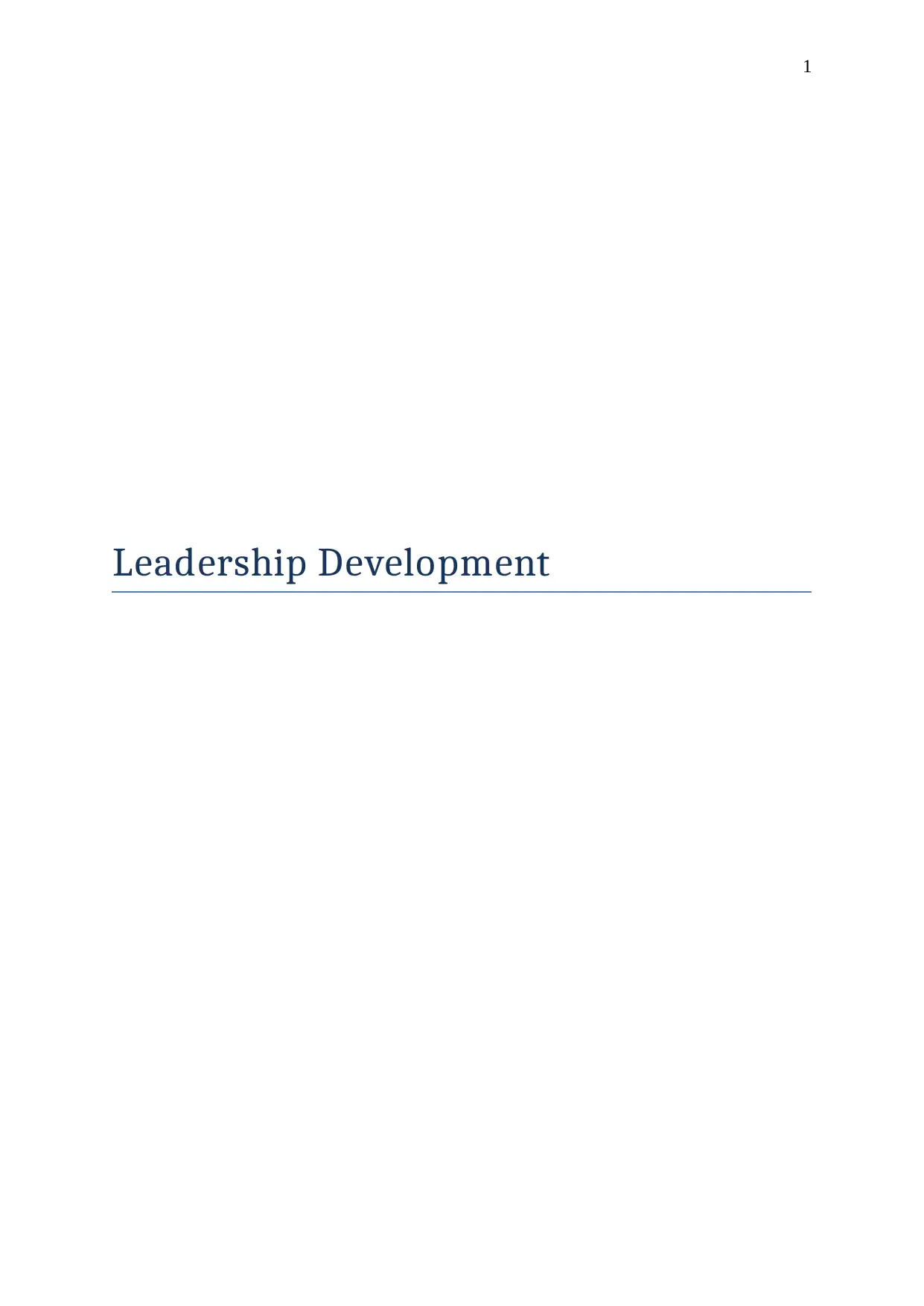
1
Leadership Development
Leadership Development
Paraphrase This Document
Need a fresh take? Get an instant paraphrase of this document with our AI Paraphraser
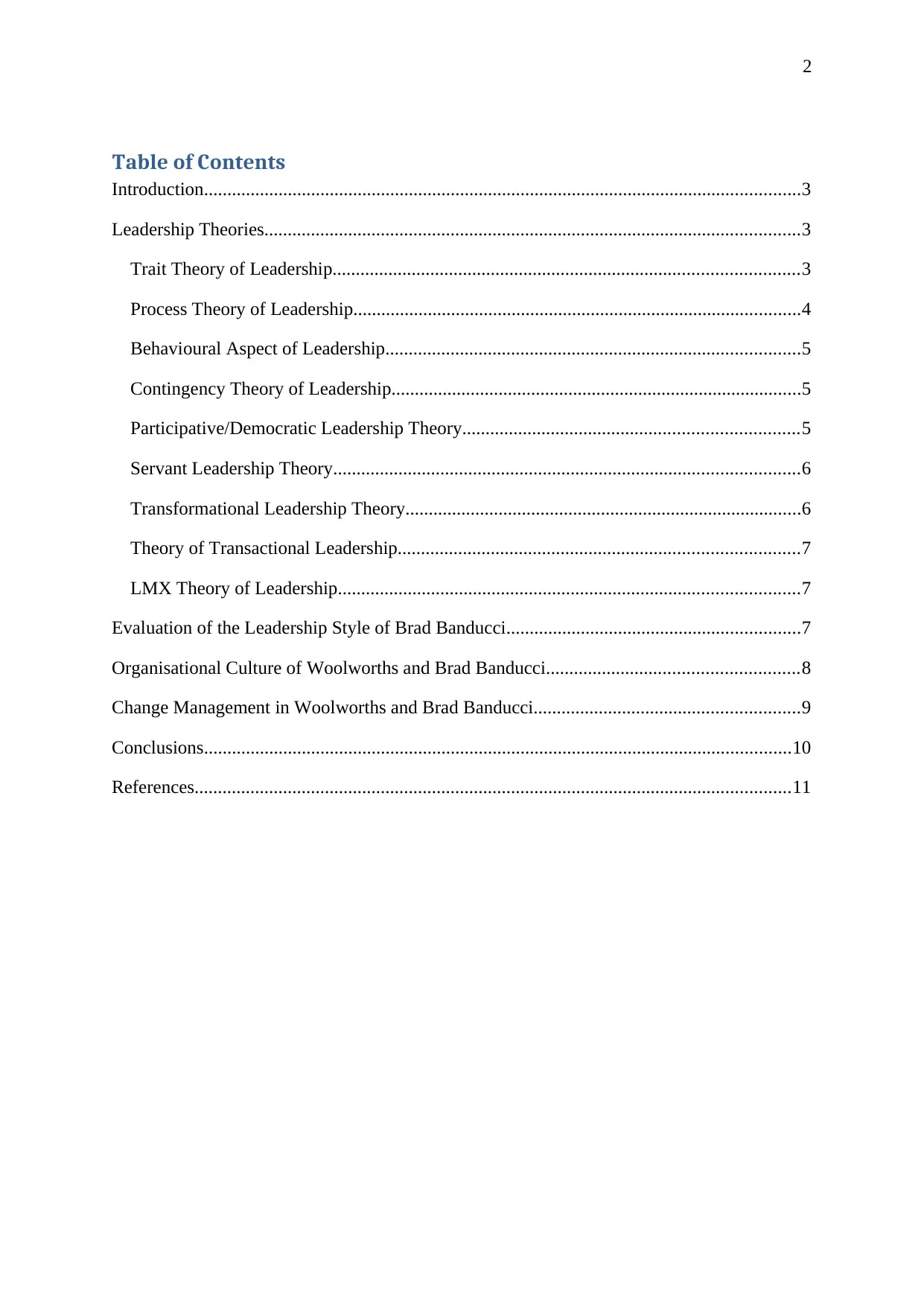
2
Table of Contents
Introduction................................................................................................................................3
Leadership Theories...................................................................................................................3
Trait Theory of Leadership....................................................................................................3
Process Theory of Leadership................................................................................................4
Behavioural Aspect of Leadership.........................................................................................5
Contingency Theory of Leadership........................................................................................5
Participative/Democratic Leadership Theory........................................................................5
Servant Leadership Theory....................................................................................................6
Transformational Leadership Theory.....................................................................................6
Theory of Transactional Leadership......................................................................................7
LMX Theory of Leadership...................................................................................................7
Evaluation of the Leadership Style of Brad Banducci...............................................................7
Organisational Culture of Woolworths and Brad Banducci......................................................8
Change Management in Woolworths and Brad Banducci.........................................................9
Conclusions..............................................................................................................................10
References................................................................................................................................11
Table of Contents
Introduction................................................................................................................................3
Leadership Theories...................................................................................................................3
Trait Theory of Leadership....................................................................................................3
Process Theory of Leadership................................................................................................4
Behavioural Aspect of Leadership.........................................................................................5
Contingency Theory of Leadership........................................................................................5
Participative/Democratic Leadership Theory........................................................................5
Servant Leadership Theory....................................................................................................6
Transformational Leadership Theory.....................................................................................6
Theory of Transactional Leadership......................................................................................7
LMX Theory of Leadership...................................................................................................7
Evaluation of the Leadership Style of Brad Banducci...............................................................7
Organisational Culture of Woolworths and Brad Banducci......................................................8
Change Management in Woolworths and Brad Banducci.........................................................9
Conclusions..............................................................................................................................10
References................................................................................................................................11
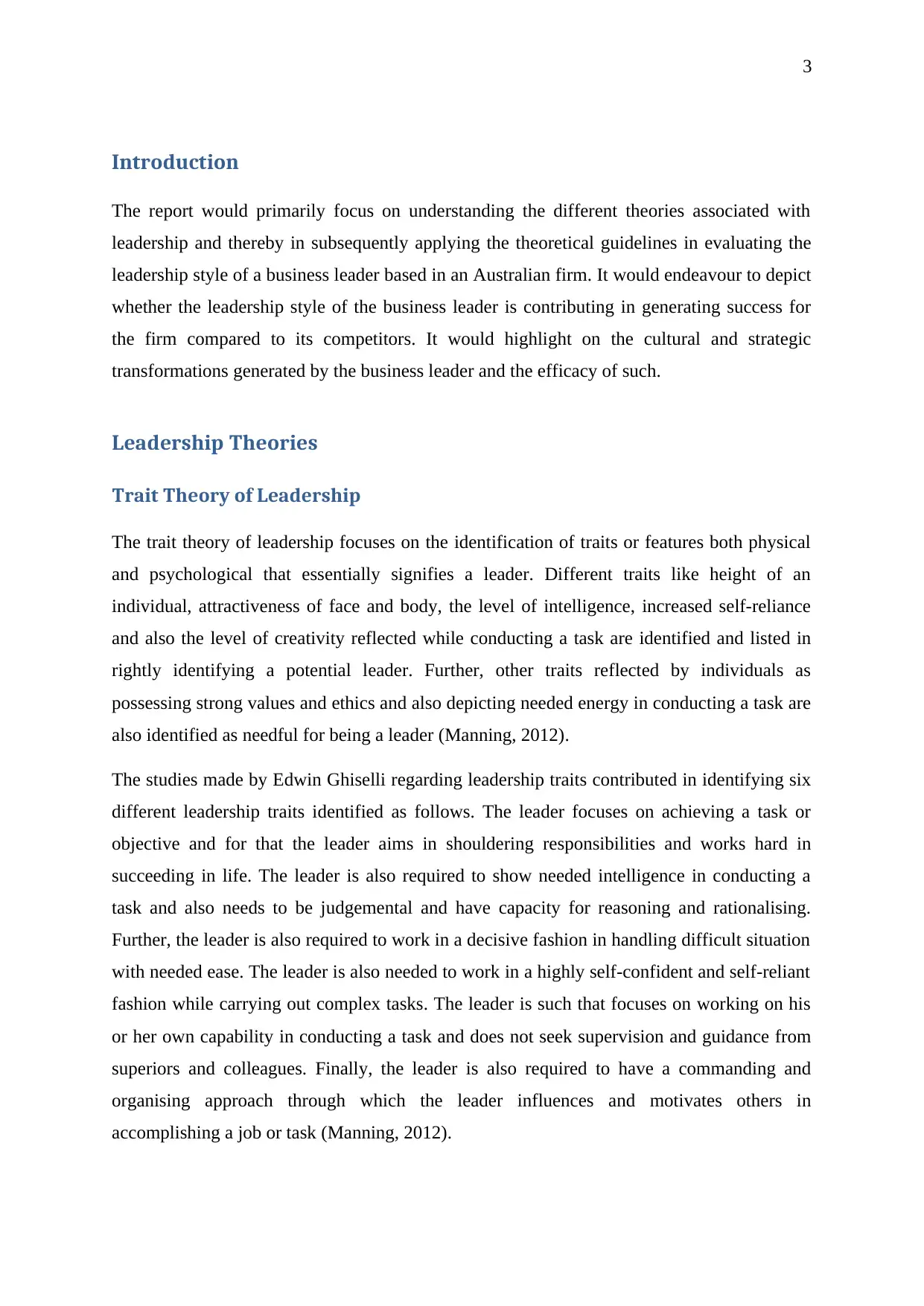
3
Introduction
The report would primarily focus on understanding the different theories associated with
leadership and thereby in subsequently applying the theoretical guidelines in evaluating the
leadership style of a business leader based in an Australian firm. It would endeavour to depict
whether the leadership style of the business leader is contributing in generating success for
the firm compared to its competitors. It would highlight on the cultural and strategic
transformations generated by the business leader and the efficacy of such.
Leadership Theories
Trait Theory of Leadership
The trait theory of leadership focuses on the identification of traits or features both physical
and psychological that essentially signifies a leader. Different traits like height of an
individual, attractiveness of face and body, the level of intelligence, increased self-reliance
and also the level of creativity reflected while conducting a task are identified and listed in
rightly identifying a potential leader. Further, other traits reflected by individuals as
possessing strong values and ethics and also depicting needed energy in conducting a task are
also identified as needful for being a leader (Manning, 2012).
The studies made by Edwin Ghiselli regarding leadership traits contributed in identifying six
different leadership traits identified as follows. The leader focuses on achieving a task or
objective and for that the leader aims in shouldering responsibilities and works hard in
succeeding in life. The leader is also required to show needed intelligence in conducting a
task and also needs to be judgemental and have capacity for reasoning and rationalising.
Further, the leader is also required to work in a decisive fashion in handling difficult situation
with needed ease. The leader is also needed to work in a highly self-confident and self-reliant
fashion while carrying out complex tasks. The leader is such that focuses on working on his
or her own capability in conducting a task and does not seek supervision and guidance from
superiors and colleagues. Finally, the leader is also required to have a commanding and
organising approach through which the leader influences and motivates others in
accomplishing a job or task (Manning, 2012).
Introduction
The report would primarily focus on understanding the different theories associated with
leadership and thereby in subsequently applying the theoretical guidelines in evaluating the
leadership style of a business leader based in an Australian firm. It would endeavour to depict
whether the leadership style of the business leader is contributing in generating success for
the firm compared to its competitors. It would highlight on the cultural and strategic
transformations generated by the business leader and the efficacy of such.
Leadership Theories
Trait Theory of Leadership
The trait theory of leadership focuses on the identification of traits or features both physical
and psychological that essentially signifies a leader. Different traits like height of an
individual, attractiveness of face and body, the level of intelligence, increased self-reliance
and also the level of creativity reflected while conducting a task are identified and listed in
rightly identifying a potential leader. Further, other traits reflected by individuals as
possessing strong values and ethics and also depicting needed energy in conducting a task are
also identified as needful for being a leader (Manning, 2012).
The studies made by Edwin Ghiselli regarding leadership traits contributed in identifying six
different leadership traits identified as follows. The leader focuses on achieving a task or
objective and for that the leader aims in shouldering responsibilities and works hard in
succeeding in life. The leader is also required to show needed intelligence in conducting a
task and also needs to be judgemental and have capacity for reasoning and rationalising.
Further, the leader is also required to work in a decisive fashion in handling difficult situation
with needed ease. The leader is also needed to work in a highly self-confident and self-reliant
fashion while carrying out complex tasks. The leader is such that focuses on working on his
or her own capability in conducting a task and does not seek supervision and guidance from
superiors and colleagues. Finally, the leader is also required to have a commanding and
organising approach through which the leader influences and motivates others in
accomplishing a job or task (Manning, 2012).
⊘ This is a preview!⊘
Do you want full access?
Subscribe today to unlock all pages.

Trusted by 1+ million students worldwide
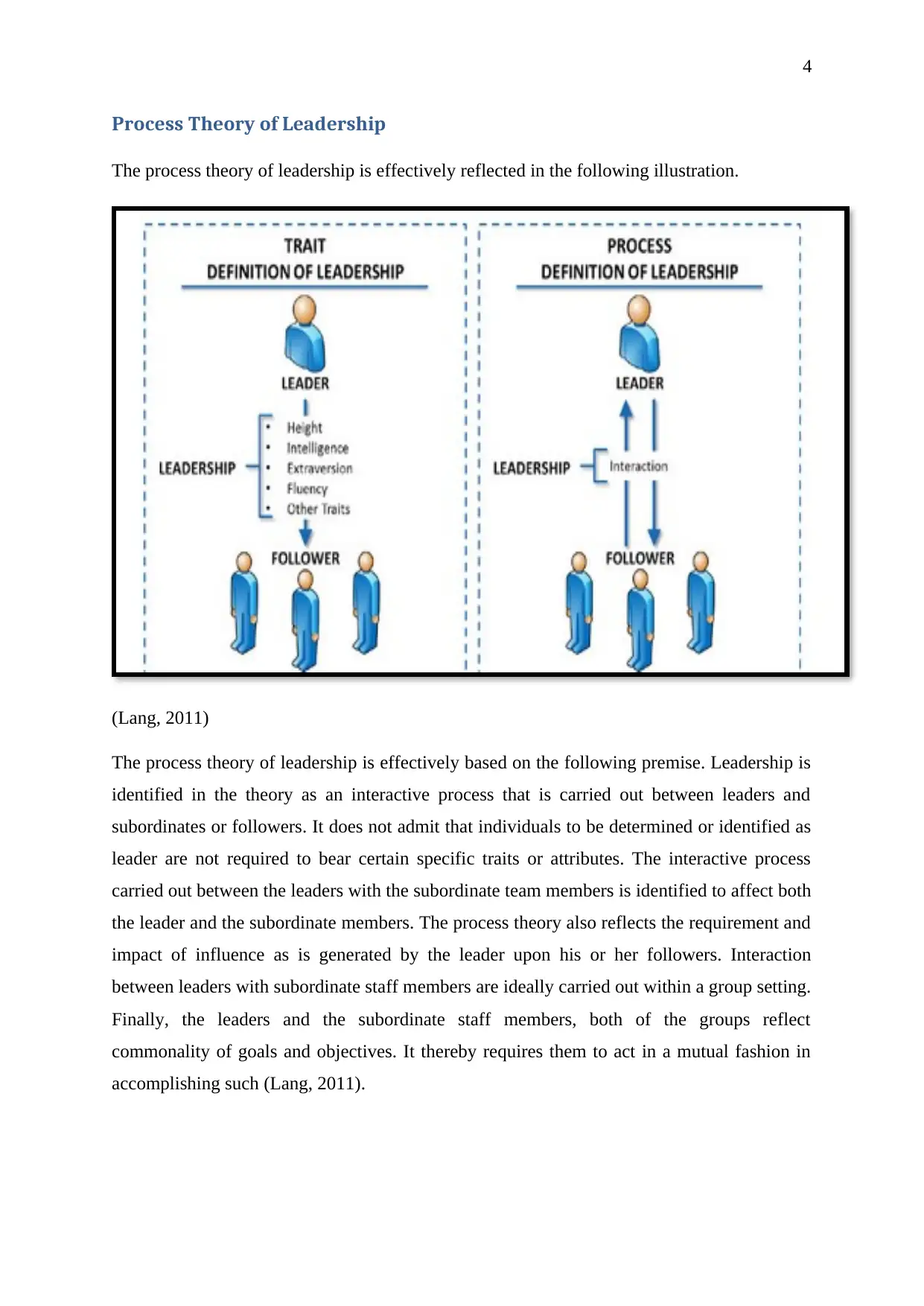
4
Process Theory of Leadership
The process theory of leadership is effectively reflected in the following illustration.
(Lang, 2011)
The process theory of leadership is effectively based on the following premise. Leadership is
identified in the theory as an interactive process that is carried out between leaders and
subordinates or followers. It does not admit that individuals to be determined or identified as
leader are not required to bear certain specific traits or attributes. The interactive process
carried out between the leaders with the subordinate team members is identified to affect both
the leader and the subordinate members. The process theory also reflects the requirement and
impact of influence as is generated by the leader upon his or her followers. Interaction
between leaders with subordinate staff members are ideally carried out within a group setting.
Finally, the leaders and the subordinate staff members, both of the groups reflect
commonality of goals and objectives. It thereby requires them to act in a mutual fashion in
accomplishing such (Lang, 2011).
Process Theory of Leadership
The process theory of leadership is effectively reflected in the following illustration.
(Lang, 2011)
The process theory of leadership is effectively based on the following premise. Leadership is
identified in the theory as an interactive process that is carried out between leaders and
subordinates or followers. It does not admit that individuals to be determined or identified as
leader are not required to bear certain specific traits or attributes. The interactive process
carried out between the leaders with the subordinate team members is identified to affect both
the leader and the subordinate members. The process theory also reflects the requirement and
impact of influence as is generated by the leader upon his or her followers. Interaction
between leaders with subordinate staff members are ideally carried out within a group setting.
Finally, the leaders and the subordinate staff members, both of the groups reflect
commonality of goals and objectives. It thereby requires them to act in a mutual fashion in
accomplishing such (Lang, 2011).
Paraphrase This Document
Need a fresh take? Get an instant paraphrase of this document with our AI Paraphraser
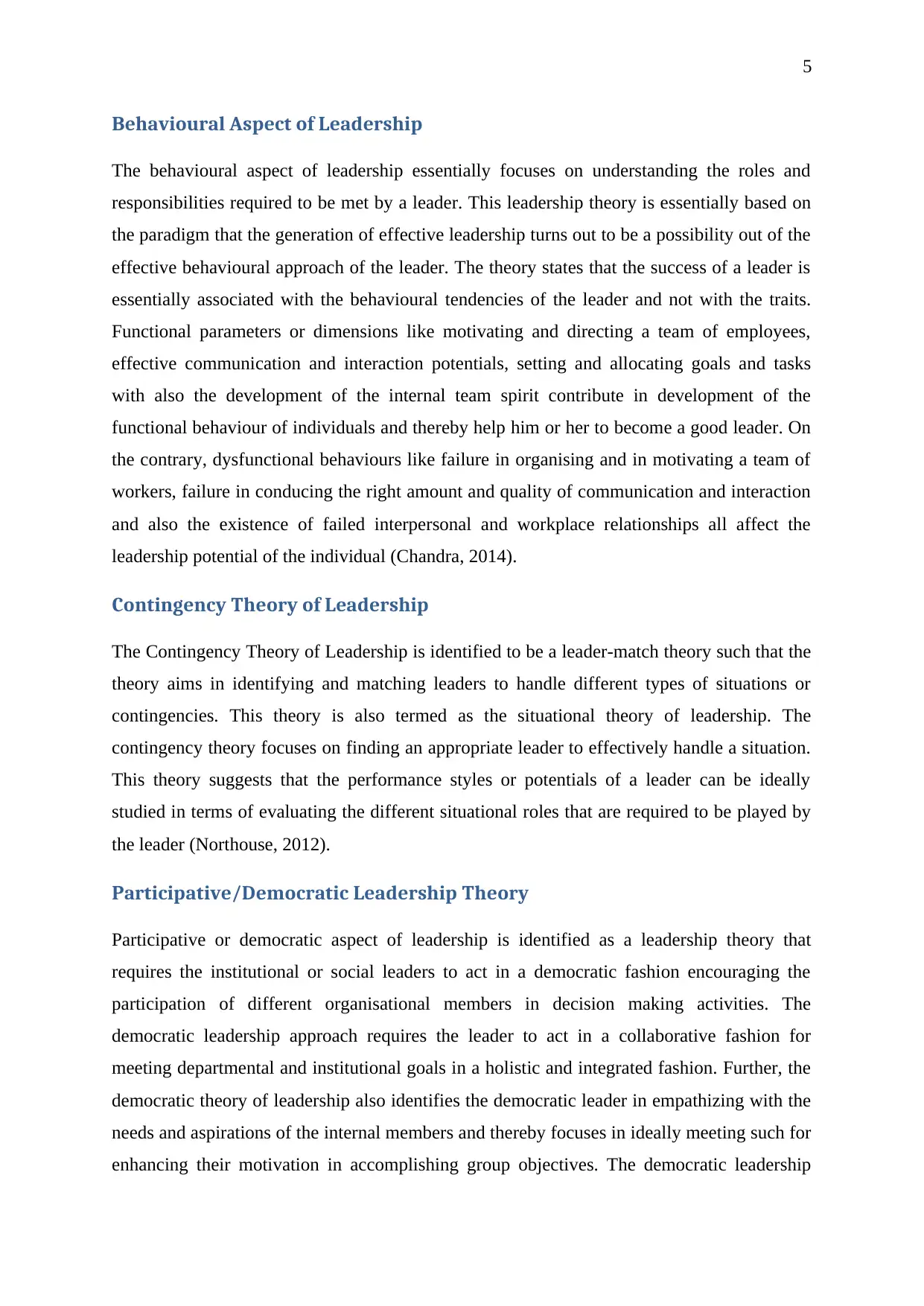
5
Behavioural Aspect of Leadership
The behavioural aspect of leadership essentially focuses on understanding the roles and
responsibilities required to be met by a leader. This leadership theory is essentially based on
the paradigm that the generation of effective leadership turns out to be a possibility out of the
effective behavioural approach of the leader. The theory states that the success of a leader is
essentially associated with the behavioural tendencies of the leader and not with the traits.
Functional parameters or dimensions like motivating and directing a team of employees,
effective communication and interaction potentials, setting and allocating goals and tasks
with also the development of the internal team spirit contribute in development of the
functional behaviour of individuals and thereby help him or her to become a good leader. On
the contrary, dysfunctional behaviours like failure in organising and in motivating a team of
workers, failure in conducing the right amount and quality of communication and interaction
and also the existence of failed interpersonal and workplace relationships all affect the
leadership potential of the individual (Chandra, 2014).
Contingency Theory of Leadership
The Contingency Theory of Leadership is identified to be a leader-match theory such that the
theory aims in identifying and matching leaders to handle different types of situations or
contingencies. This theory is also termed as the situational theory of leadership. The
contingency theory focuses on finding an appropriate leader to effectively handle a situation.
This theory suggests that the performance styles or potentials of a leader can be ideally
studied in terms of evaluating the different situational roles that are required to be played by
the leader (Northouse, 2012).
Participative/Democratic Leadership Theory
Participative or democratic aspect of leadership is identified as a leadership theory that
requires the institutional or social leaders to act in a democratic fashion encouraging the
participation of different organisational members in decision making activities. The
democratic leadership approach requires the leader to act in a collaborative fashion for
meeting departmental and institutional goals in a holistic and integrated fashion. Further, the
democratic theory of leadership also identifies the democratic leader in empathizing with the
needs and aspirations of the internal members and thereby focuses in ideally meeting such for
enhancing their motivation in accomplishing group objectives. The democratic leadership
Behavioural Aspect of Leadership
The behavioural aspect of leadership essentially focuses on understanding the roles and
responsibilities required to be met by a leader. This leadership theory is essentially based on
the paradigm that the generation of effective leadership turns out to be a possibility out of the
effective behavioural approach of the leader. The theory states that the success of a leader is
essentially associated with the behavioural tendencies of the leader and not with the traits.
Functional parameters or dimensions like motivating and directing a team of employees,
effective communication and interaction potentials, setting and allocating goals and tasks
with also the development of the internal team spirit contribute in development of the
functional behaviour of individuals and thereby help him or her to become a good leader. On
the contrary, dysfunctional behaviours like failure in organising and in motivating a team of
workers, failure in conducing the right amount and quality of communication and interaction
and also the existence of failed interpersonal and workplace relationships all affect the
leadership potential of the individual (Chandra, 2014).
Contingency Theory of Leadership
The Contingency Theory of Leadership is identified to be a leader-match theory such that the
theory aims in identifying and matching leaders to handle different types of situations or
contingencies. This theory is also termed as the situational theory of leadership. The
contingency theory focuses on finding an appropriate leader to effectively handle a situation.
This theory suggests that the performance styles or potentials of a leader can be ideally
studied in terms of evaluating the different situational roles that are required to be played by
the leader (Northouse, 2012).
Participative/Democratic Leadership Theory
Participative or democratic aspect of leadership is identified as a leadership theory that
requires the institutional or social leaders to act in a democratic fashion encouraging the
participation of different organisational members in decision making activities. The
democratic leadership approach requires the leader to act in a collaborative fashion for
meeting departmental and institutional goals in a holistic and integrated fashion. Further, the
democratic theory of leadership also identifies the democratic leader in empathizing with the
needs and aspirations of the internal members and thereby focuses in ideally meeting such for
enhancing their motivation in accomplishing group objectives. The democratic leadership
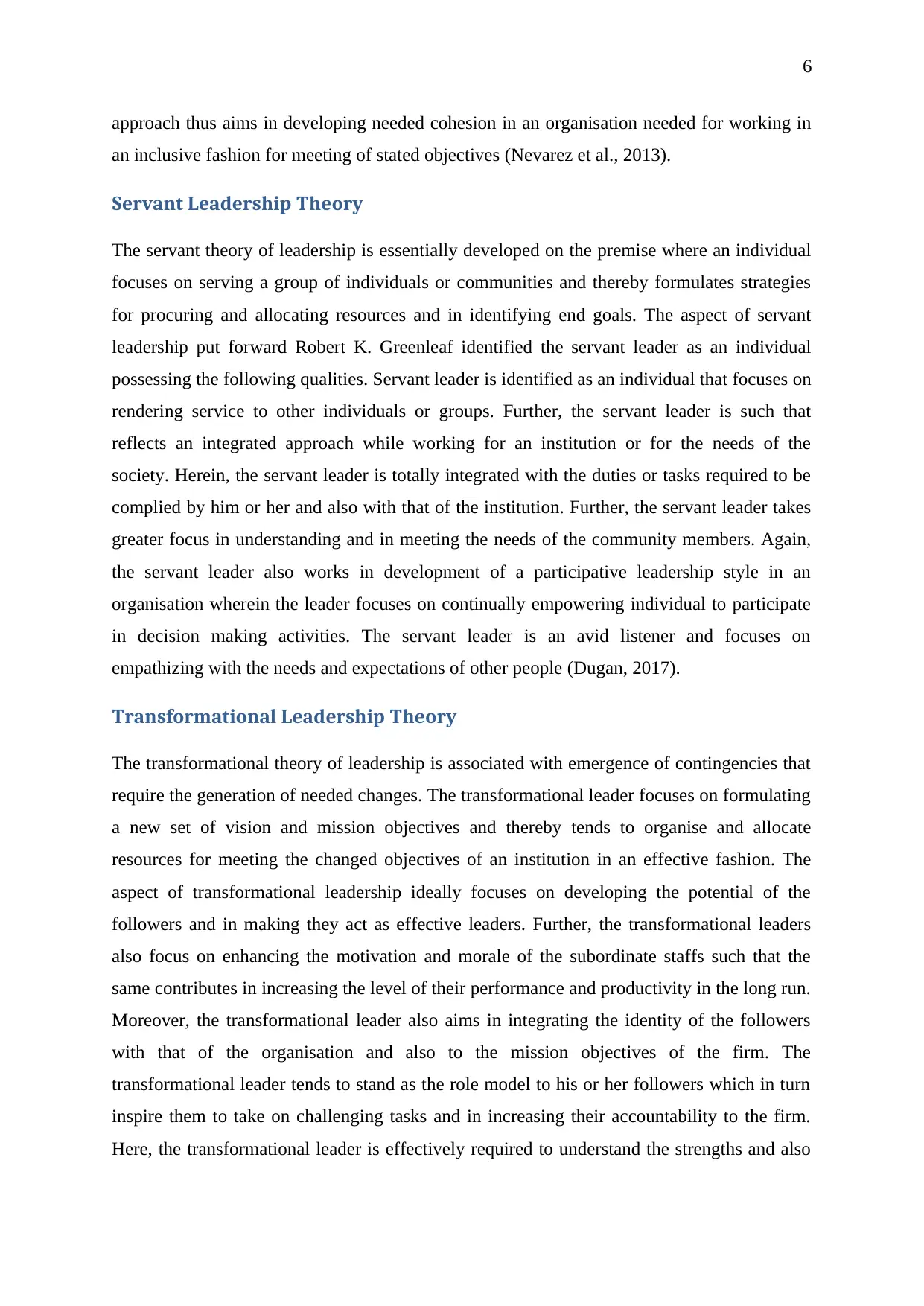
6
approach thus aims in developing needed cohesion in an organisation needed for working in
an inclusive fashion for meeting of stated objectives (Nevarez et al., 2013).
Servant Leadership Theory
The servant theory of leadership is essentially developed on the premise where an individual
focuses on serving a group of individuals or communities and thereby formulates strategies
for procuring and allocating resources and in identifying end goals. The aspect of servant
leadership put forward Robert K. Greenleaf identified the servant leader as an individual
possessing the following qualities. Servant leader is identified as an individual that focuses on
rendering service to other individuals or groups. Further, the servant leader is such that
reflects an integrated approach while working for an institution or for the needs of the
society. Herein, the servant leader is totally integrated with the duties or tasks required to be
complied by him or her and also with that of the institution. Further, the servant leader takes
greater focus in understanding and in meeting the needs of the community members. Again,
the servant leader also works in development of a participative leadership style in an
organisation wherein the leader focuses on continually empowering individual to participate
in decision making activities. The servant leader is an avid listener and focuses on
empathizing with the needs and expectations of other people (Dugan, 2017).
Transformational Leadership Theory
The transformational theory of leadership is associated with emergence of contingencies that
require the generation of needed changes. The transformational leader focuses on formulating
a new set of vision and mission objectives and thereby tends to organise and allocate
resources for meeting the changed objectives of an institution in an effective fashion. The
aspect of transformational leadership ideally focuses on developing the potential of the
followers and in making they act as effective leaders. Further, the transformational leaders
also focus on enhancing the motivation and morale of the subordinate staffs such that the
same contributes in increasing the level of their performance and productivity in the long run.
Moreover, the transformational leader also aims in integrating the identity of the followers
with that of the organisation and also to the mission objectives of the firm. The
transformational leader tends to stand as the role model to his or her followers which in turn
inspire them to take on challenging tasks and in increasing their accountability to the firm.
Here, the transformational leader is effectively required to understand the strengths and also
approach thus aims in developing needed cohesion in an organisation needed for working in
an inclusive fashion for meeting of stated objectives (Nevarez et al., 2013).
Servant Leadership Theory
The servant theory of leadership is essentially developed on the premise where an individual
focuses on serving a group of individuals or communities and thereby formulates strategies
for procuring and allocating resources and in identifying end goals. The aspect of servant
leadership put forward Robert K. Greenleaf identified the servant leader as an individual
possessing the following qualities. Servant leader is identified as an individual that focuses on
rendering service to other individuals or groups. Further, the servant leader is such that
reflects an integrated approach while working for an institution or for the needs of the
society. Herein, the servant leader is totally integrated with the duties or tasks required to be
complied by him or her and also with that of the institution. Further, the servant leader takes
greater focus in understanding and in meeting the needs of the community members. Again,
the servant leader also works in development of a participative leadership style in an
organisation wherein the leader focuses on continually empowering individual to participate
in decision making activities. The servant leader is an avid listener and focuses on
empathizing with the needs and expectations of other people (Dugan, 2017).
Transformational Leadership Theory
The transformational theory of leadership is associated with emergence of contingencies that
require the generation of needed changes. The transformational leader focuses on formulating
a new set of vision and mission objectives and thereby tends to organise and allocate
resources for meeting the changed objectives of an institution in an effective fashion. The
aspect of transformational leadership ideally focuses on developing the potential of the
followers and in making they act as effective leaders. Further, the transformational leaders
also focus on enhancing the motivation and morale of the subordinate staffs such that the
same contributes in increasing the level of their performance and productivity in the long run.
Moreover, the transformational leader also aims in integrating the identity of the followers
with that of the organisation and also to the mission objectives of the firm. The
transformational leader tends to stand as the role model to his or her followers which in turn
inspire them to take on challenging tasks and in increasing their accountability to the firm.
Here, the transformational leader is effectively required to understand the strengths and also
⊘ This is a preview!⊘
Do you want full access?
Subscribe today to unlock all pages.

Trusted by 1+ million students worldwide
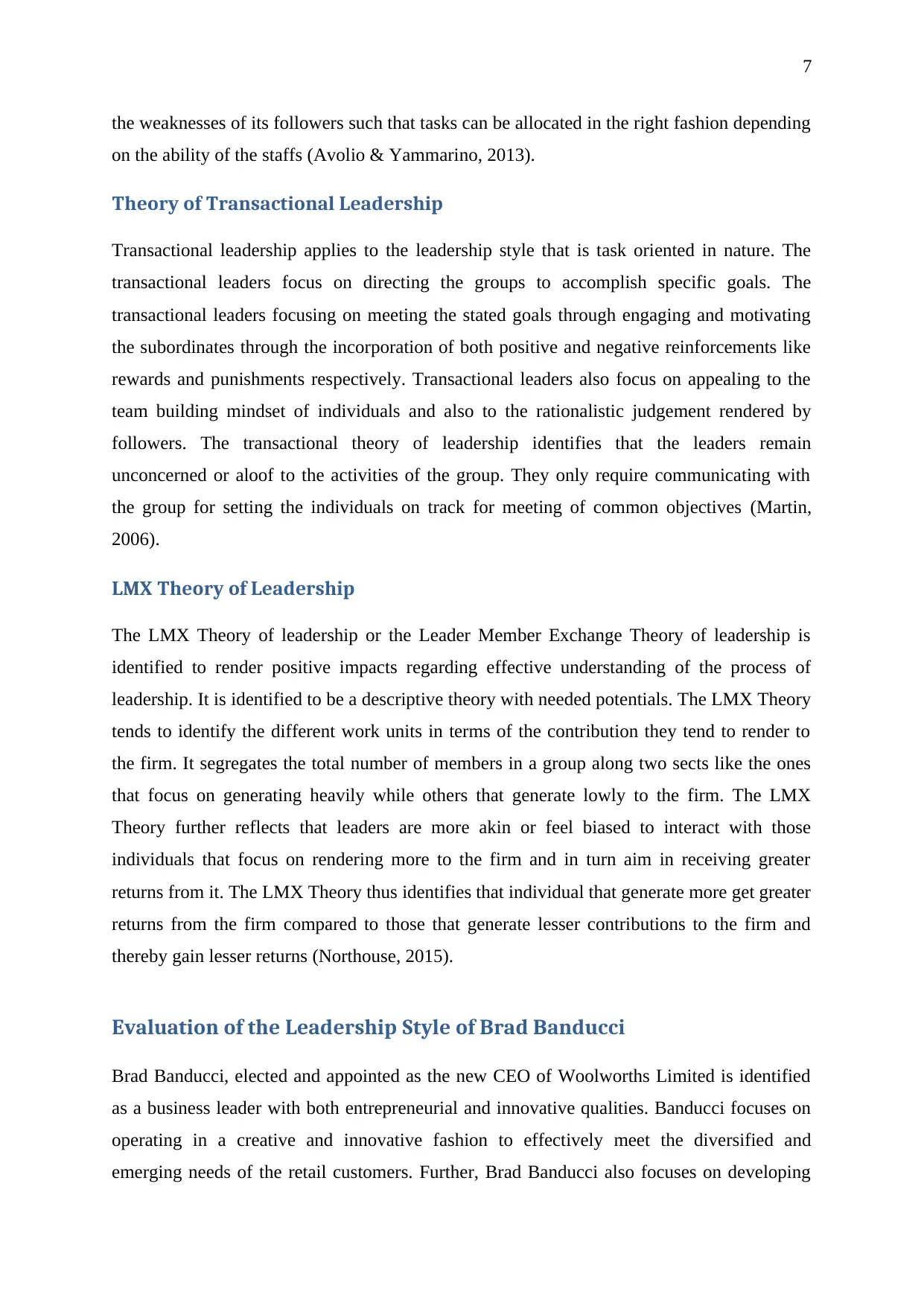
7
the weaknesses of its followers such that tasks can be allocated in the right fashion depending
on the ability of the staffs (Avolio & Yammarino, 2013).
Theory of Transactional Leadership
Transactional leadership applies to the leadership style that is task oriented in nature. The
transactional leaders focus on directing the groups to accomplish specific goals. The
transactional leaders focusing on meeting the stated goals through engaging and motivating
the subordinates through the incorporation of both positive and negative reinforcements like
rewards and punishments respectively. Transactional leaders also focus on appealing to the
team building mindset of individuals and also to the rationalistic judgement rendered by
followers. The transactional theory of leadership identifies that the leaders remain
unconcerned or aloof to the activities of the group. They only require communicating with
the group for setting the individuals on track for meeting of common objectives (Martin,
2006).
LMX Theory of Leadership
The LMX Theory of leadership or the Leader Member Exchange Theory of leadership is
identified to render positive impacts regarding effective understanding of the process of
leadership. It is identified to be a descriptive theory with needed potentials. The LMX Theory
tends to identify the different work units in terms of the contribution they tend to render to
the firm. It segregates the total number of members in a group along two sects like the ones
that focus on generating heavily while others that generate lowly to the firm. The LMX
Theory further reflects that leaders are more akin or feel biased to interact with those
individuals that focus on rendering more to the firm and in turn aim in receiving greater
returns from it. The LMX Theory thus identifies that individual that generate more get greater
returns from the firm compared to those that generate lesser contributions to the firm and
thereby gain lesser returns (Northouse, 2015).
Evaluation of the Leadership Style of Brad Banducci
Brad Banducci, elected and appointed as the new CEO of Woolworths Limited is identified
as a business leader with both entrepreneurial and innovative qualities. Banducci focuses on
operating in a creative and innovative fashion to effectively meet the diversified and
emerging needs of the retail customers. Further, Brad Banducci also focuses on developing
the weaknesses of its followers such that tasks can be allocated in the right fashion depending
on the ability of the staffs (Avolio & Yammarino, 2013).
Theory of Transactional Leadership
Transactional leadership applies to the leadership style that is task oriented in nature. The
transactional leaders focus on directing the groups to accomplish specific goals. The
transactional leaders focusing on meeting the stated goals through engaging and motivating
the subordinates through the incorporation of both positive and negative reinforcements like
rewards and punishments respectively. Transactional leaders also focus on appealing to the
team building mindset of individuals and also to the rationalistic judgement rendered by
followers. The transactional theory of leadership identifies that the leaders remain
unconcerned or aloof to the activities of the group. They only require communicating with
the group for setting the individuals on track for meeting of common objectives (Martin,
2006).
LMX Theory of Leadership
The LMX Theory of leadership or the Leader Member Exchange Theory of leadership is
identified to render positive impacts regarding effective understanding of the process of
leadership. It is identified to be a descriptive theory with needed potentials. The LMX Theory
tends to identify the different work units in terms of the contribution they tend to render to
the firm. It segregates the total number of members in a group along two sects like the ones
that focus on generating heavily while others that generate lowly to the firm. The LMX
Theory further reflects that leaders are more akin or feel biased to interact with those
individuals that focus on rendering more to the firm and in turn aim in receiving greater
returns from it. The LMX Theory thus identifies that individual that generate more get greater
returns from the firm compared to those that generate lesser contributions to the firm and
thereby gain lesser returns (Northouse, 2015).
Evaluation of the Leadership Style of Brad Banducci
Brad Banducci, elected and appointed as the new CEO of Woolworths Limited is identified
as a business leader with both entrepreneurial and innovative qualities. Banducci focuses on
operating in a creative and innovative fashion to effectively meet the diversified and
emerging needs of the retail customers. Further, Brad Banducci also focuses on developing
Paraphrase This Document
Need a fresh take? Get an instant paraphrase of this document with our AI Paraphraser
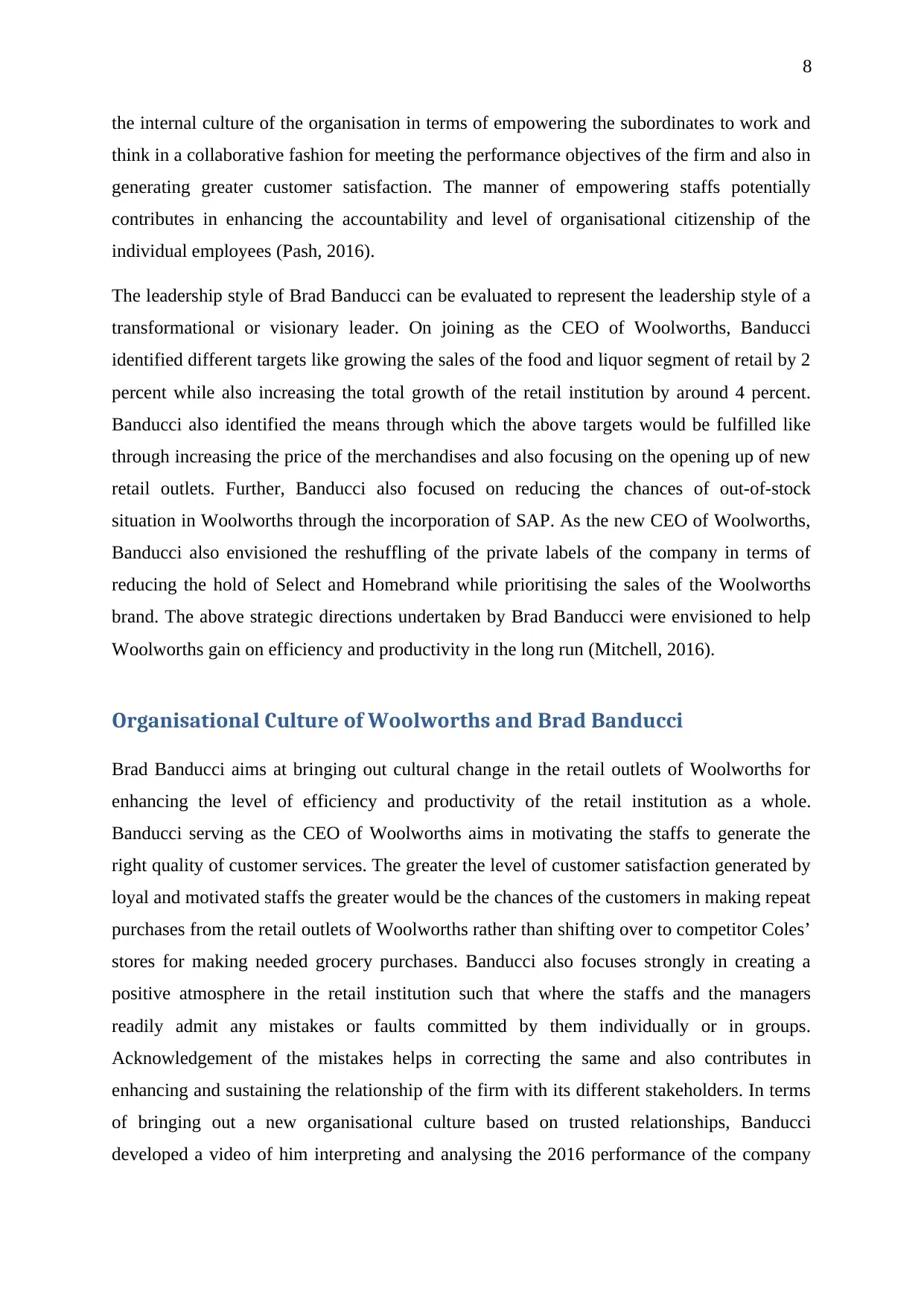
8
the internal culture of the organisation in terms of empowering the subordinates to work and
think in a collaborative fashion for meeting the performance objectives of the firm and also in
generating greater customer satisfaction. The manner of empowering staffs potentially
contributes in enhancing the accountability and level of organisational citizenship of the
individual employees (Pash, 2016).
The leadership style of Brad Banducci can be evaluated to represent the leadership style of a
transformational or visionary leader. On joining as the CEO of Woolworths, Banducci
identified different targets like growing the sales of the food and liquor segment of retail by 2
percent while also increasing the total growth of the retail institution by around 4 percent.
Banducci also identified the means through which the above targets would be fulfilled like
through increasing the price of the merchandises and also focusing on the opening up of new
retail outlets. Further, Banducci also focused on reducing the chances of out-of-stock
situation in Woolworths through the incorporation of SAP. As the new CEO of Woolworths,
Banducci also envisioned the reshuffling of the private labels of the company in terms of
reducing the hold of Select and Homebrand while prioritising the sales of the Woolworths
brand. The above strategic directions undertaken by Brad Banducci were envisioned to help
Woolworths gain on efficiency and productivity in the long run (Mitchell, 2016).
Organisational Culture of Woolworths and Brad Banducci
Brad Banducci aims at bringing out cultural change in the retail outlets of Woolworths for
enhancing the level of efficiency and productivity of the retail institution as a whole.
Banducci serving as the CEO of Woolworths aims in motivating the staffs to generate the
right quality of customer services. The greater the level of customer satisfaction generated by
loyal and motivated staffs the greater would be the chances of the customers in making repeat
purchases from the retail outlets of Woolworths rather than shifting over to competitor Coles’
stores for making needed grocery purchases. Banducci also focuses strongly in creating a
positive atmosphere in the retail institution such that where the staffs and the managers
readily admit any mistakes or faults committed by them individually or in groups.
Acknowledgement of the mistakes helps in correcting the same and also contributes in
enhancing and sustaining the relationship of the firm with its different stakeholders. In terms
of bringing out a new organisational culture based on trusted relationships, Banducci
developed a video of him interpreting and analysing the 2016 performance of the company
the internal culture of the organisation in terms of empowering the subordinates to work and
think in a collaborative fashion for meeting the performance objectives of the firm and also in
generating greater customer satisfaction. The manner of empowering staffs potentially
contributes in enhancing the accountability and level of organisational citizenship of the
individual employees (Pash, 2016).
The leadership style of Brad Banducci can be evaluated to represent the leadership style of a
transformational or visionary leader. On joining as the CEO of Woolworths, Banducci
identified different targets like growing the sales of the food and liquor segment of retail by 2
percent while also increasing the total growth of the retail institution by around 4 percent.
Banducci also identified the means through which the above targets would be fulfilled like
through increasing the price of the merchandises and also focusing on the opening up of new
retail outlets. Further, Banducci also focused on reducing the chances of out-of-stock
situation in Woolworths through the incorporation of SAP. As the new CEO of Woolworths,
Banducci also envisioned the reshuffling of the private labels of the company in terms of
reducing the hold of Select and Homebrand while prioritising the sales of the Woolworths
brand. The above strategic directions undertaken by Brad Banducci were envisioned to help
Woolworths gain on efficiency and productivity in the long run (Mitchell, 2016).
Organisational Culture of Woolworths and Brad Banducci
Brad Banducci aims at bringing out cultural change in the retail outlets of Woolworths for
enhancing the level of efficiency and productivity of the retail institution as a whole.
Banducci serving as the CEO of Woolworths aims in motivating the staffs to generate the
right quality of customer services. The greater the level of customer satisfaction generated by
loyal and motivated staffs the greater would be the chances of the customers in making repeat
purchases from the retail outlets of Woolworths rather than shifting over to competitor Coles’
stores for making needed grocery purchases. Banducci also focuses strongly in creating a
positive atmosphere in the retail institution such that where the staffs and the managers
readily admit any mistakes or faults committed by them individually or in groups.
Acknowledgement of the mistakes helps in correcting the same and also contributes in
enhancing and sustaining the relationship of the firm with its different stakeholders. In terms
of bringing out a new organisational culture based on trusted relationships, Banducci
developed a video of him interpreting and analysing the 2016 performance of the company
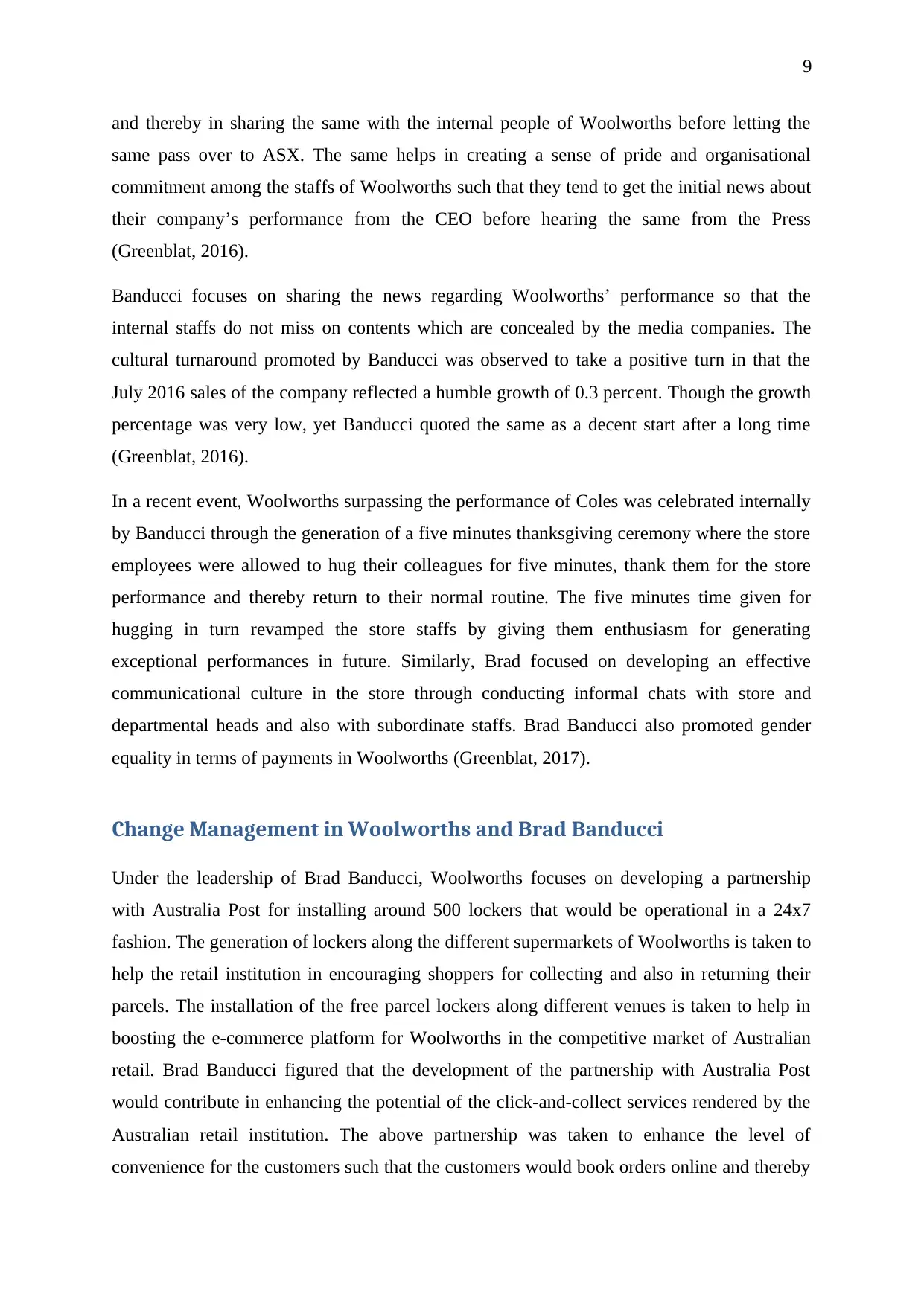
9
and thereby in sharing the same with the internal people of Woolworths before letting the
same pass over to ASX. The same helps in creating a sense of pride and organisational
commitment among the staffs of Woolworths such that they tend to get the initial news about
their company’s performance from the CEO before hearing the same from the Press
(Greenblat, 2016).
Banducci focuses on sharing the news regarding Woolworths’ performance so that the
internal staffs do not miss on contents which are concealed by the media companies. The
cultural turnaround promoted by Banducci was observed to take a positive turn in that the
July 2016 sales of the company reflected a humble growth of 0.3 percent. Though the growth
percentage was very low, yet Banducci quoted the same as a decent start after a long time
(Greenblat, 2016).
In a recent event, Woolworths surpassing the performance of Coles was celebrated internally
by Banducci through the generation of a five minutes thanksgiving ceremony where the store
employees were allowed to hug their colleagues for five minutes, thank them for the store
performance and thereby return to their normal routine. The five minutes time given for
hugging in turn revamped the store staffs by giving them enthusiasm for generating
exceptional performances in future. Similarly, Brad focused on developing an effective
communicational culture in the store through conducting informal chats with store and
departmental heads and also with subordinate staffs. Brad Banducci also promoted gender
equality in terms of payments in Woolworths (Greenblat, 2017).
Change Management in Woolworths and Brad Banducci
Under the leadership of Brad Banducci, Woolworths focuses on developing a partnership
with Australia Post for installing around 500 lockers that would be operational in a 24x7
fashion. The generation of lockers along the different supermarkets of Woolworths is taken to
help the retail institution in encouraging shoppers for collecting and also in returning their
parcels. The installation of the free parcel lockers along different venues is taken to help in
boosting the e-commerce platform for Woolworths in the competitive market of Australian
retail. Brad Banducci figured that the development of the partnership with Australia Post
would contribute in enhancing the potential of the click-and-collect services rendered by the
Australian retail institution. The above partnership was taken to enhance the level of
convenience for the customers such that the customers would book orders online and thereby
and thereby in sharing the same with the internal people of Woolworths before letting the
same pass over to ASX. The same helps in creating a sense of pride and organisational
commitment among the staffs of Woolworths such that they tend to get the initial news about
their company’s performance from the CEO before hearing the same from the Press
(Greenblat, 2016).
Banducci focuses on sharing the news regarding Woolworths’ performance so that the
internal staffs do not miss on contents which are concealed by the media companies. The
cultural turnaround promoted by Banducci was observed to take a positive turn in that the
July 2016 sales of the company reflected a humble growth of 0.3 percent. Though the growth
percentage was very low, yet Banducci quoted the same as a decent start after a long time
(Greenblat, 2016).
In a recent event, Woolworths surpassing the performance of Coles was celebrated internally
by Banducci through the generation of a five minutes thanksgiving ceremony where the store
employees were allowed to hug their colleagues for five minutes, thank them for the store
performance and thereby return to their normal routine. The five minutes time given for
hugging in turn revamped the store staffs by giving them enthusiasm for generating
exceptional performances in future. Similarly, Brad focused on developing an effective
communicational culture in the store through conducting informal chats with store and
departmental heads and also with subordinate staffs. Brad Banducci also promoted gender
equality in terms of payments in Woolworths (Greenblat, 2017).
Change Management in Woolworths and Brad Banducci
Under the leadership of Brad Banducci, Woolworths focuses on developing a partnership
with Australia Post for installing around 500 lockers that would be operational in a 24x7
fashion. The generation of lockers along the different supermarkets of Woolworths is taken to
help the retail institution in encouraging shoppers for collecting and also in returning their
parcels. The installation of the free parcel lockers along different venues is taken to help in
boosting the e-commerce platform for Woolworths in the competitive market of Australian
retail. Brad Banducci figured that the development of the partnership with Australia Post
would contribute in enhancing the potential of the click-and-collect services rendered by the
Australian retail institution. The above partnership was taken to enhance the level of
convenience for the customers such that the customers would book orders online and thereby
⊘ This is a preview!⊘
Do you want full access?
Subscribe today to unlock all pages.

Trusted by 1+ million students worldwide
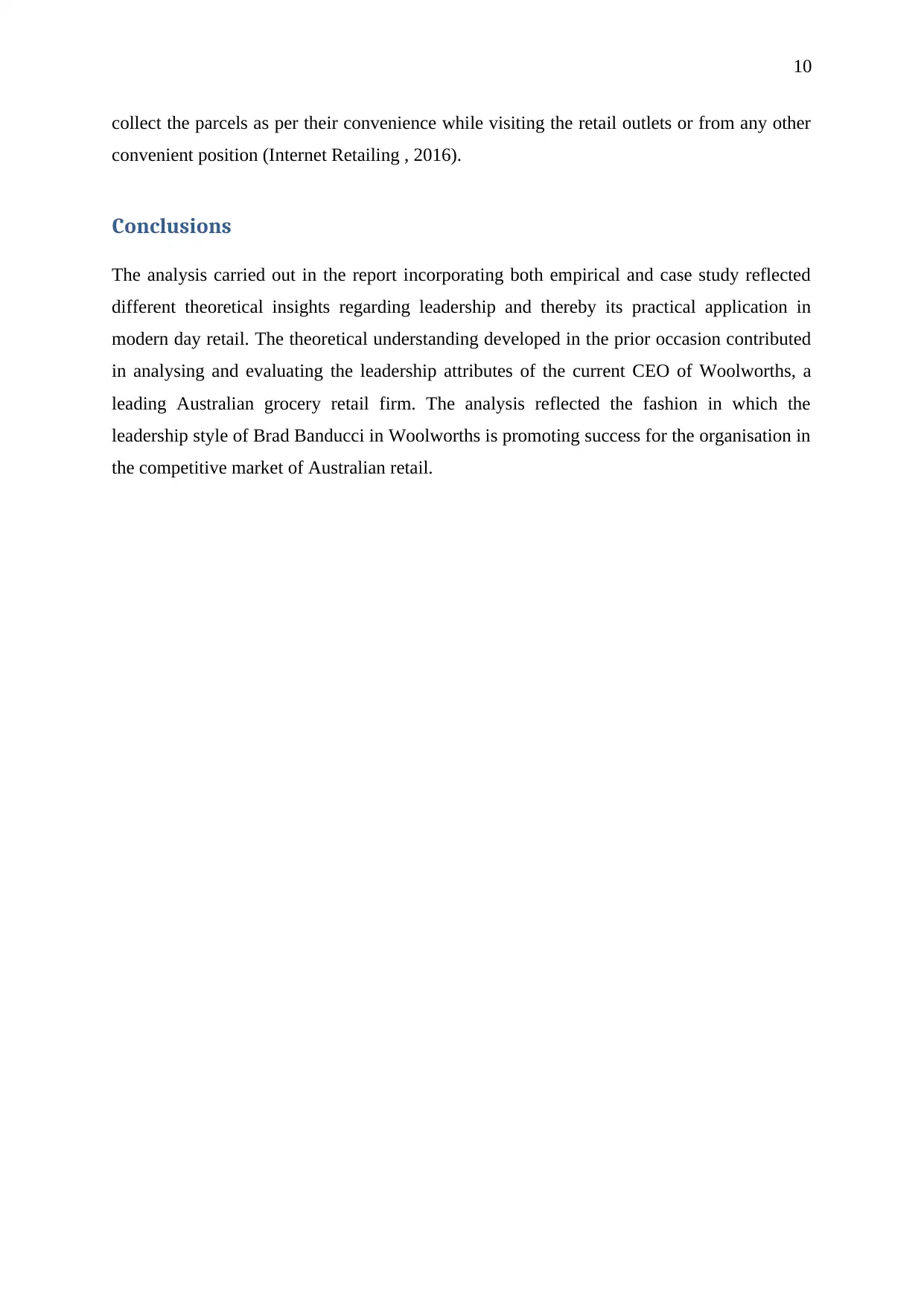
10
collect the parcels as per their convenience while visiting the retail outlets or from any other
convenient position (Internet Retailing , 2016).
Conclusions
The analysis carried out in the report incorporating both empirical and case study reflected
different theoretical insights regarding leadership and thereby its practical application in
modern day retail. The theoretical understanding developed in the prior occasion contributed
in analysing and evaluating the leadership attributes of the current CEO of Woolworths, a
leading Australian grocery retail firm. The analysis reflected the fashion in which the
leadership style of Brad Banducci in Woolworths is promoting success for the organisation in
the competitive market of Australian retail.
collect the parcels as per their convenience while visiting the retail outlets or from any other
convenient position (Internet Retailing , 2016).
Conclusions
The analysis carried out in the report incorporating both empirical and case study reflected
different theoretical insights regarding leadership and thereby its practical application in
modern day retail. The theoretical understanding developed in the prior occasion contributed
in analysing and evaluating the leadership attributes of the current CEO of Woolworths, a
leading Australian grocery retail firm. The analysis reflected the fashion in which the
leadership style of Brad Banducci in Woolworths is promoting success for the organisation in
the competitive market of Australian retail.
Paraphrase This Document
Need a fresh take? Get an instant paraphrase of this document with our AI Paraphraser
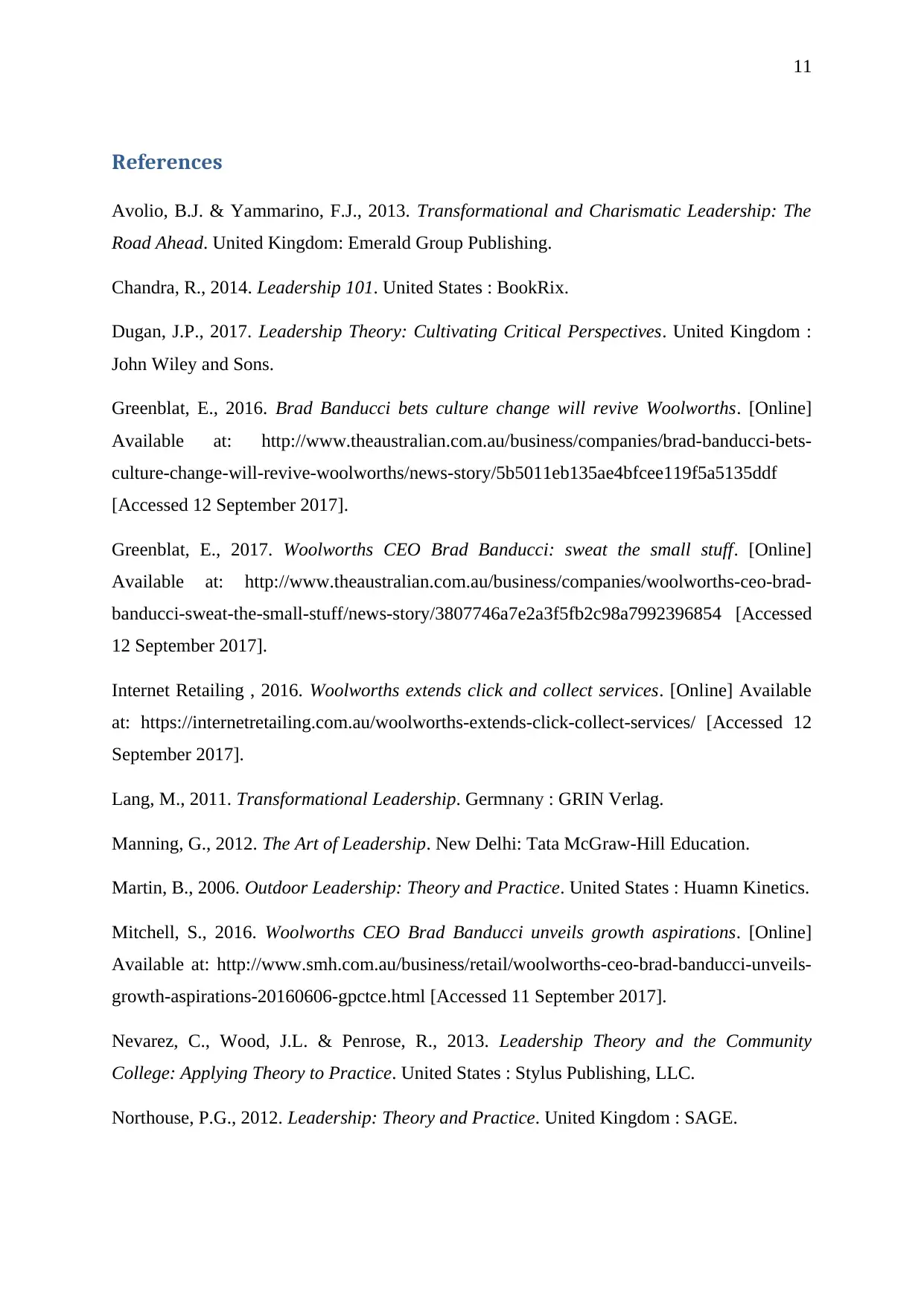
11
References
Avolio, B.J. & Yammarino, F.J., 2013. Transformational and Charismatic Leadership: The
Road Ahead. United Kingdom: Emerald Group Publishing.
Chandra, R., 2014. Leadership 101. United States : BookRix.
Dugan, J.P., 2017. Leadership Theory: Cultivating Critical Perspectives. United Kingdom :
John Wiley and Sons.
Greenblat, E., 2016. Brad Banducci bets culture change will revive Woolworths. [Online]
Available at: http://www.theaustralian.com.au/business/companies/brad-banducci-bets-
culture-change-will-revive-woolworths/news-story/5b5011eb135ae4bfcee119f5a5135ddf
[Accessed 12 September 2017].
Greenblat, E., 2017. Woolworths CEO Brad Banducci: sweat the small stuff. [Online]
Available at: http://www.theaustralian.com.au/business/companies/woolworths-ceo-brad-
banducci-sweat-the-small-stuff/news-story/3807746a7e2a3f5fb2c98a7992396854 [Accessed
12 September 2017].
Internet Retailing , 2016. Woolworths extends click and collect services. [Online] Available
at: https://internetretailing.com.au/woolworths-extends-click-collect-services/ [Accessed 12
September 2017].
Lang, M., 2011. Transformational Leadership. Germnany : GRIN Verlag.
Manning, G., 2012. The Art of Leadership. New Delhi: Tata McGraw-Hill Education.
Martin, B., 2006. Outdoor Leadership: Theory and Practice. United States : Huamn Kinetics.
Mitchell, S., 2016. Woolworths CEO Brad Banducci unveils growth aspirations. [Online]
Available at: http://www.smh.com.au/business/retail/woolworths-ceo-brad-banducci-unveils-
growth-aspirations-20160606-gpctce.html [Accessed 11 September 2017].
Nevarez, C., Wood, J.L. & Penrose, R., 2013. Leadership Theory and the Community
College: Applying Theory to Practice. United States : Stylus Publishing, LLC.
Northouse, P.G., 2012. Leadership: Theory and Practice. United Kingdom : SAGE.
References
Avolio, B.J. & Yammarino, F.J., 2013. Transformational and Charismatic Leadership: The
Road Ahead. United Kingdom: Emerald Group Publishing.
Chandra, R., 2014. Leadership 101. United States : BookRix.
Dugan, J.P., 2017. Leadership Theory: Cultivating Critical Perspectives. United Kingdom :
John Wiley and Sons.
Greenblat, E., 2016. Brad Banducci bets culture change will revive Woolworths. [Online]
Available at: http://www.theaustralian.com.au/business/companies/brad-banducci-bets-
culture-change-will-revive-woolworths/news-story/5b5011eb135ae4bfcee119f5a5135ddf
[Accessed 12 September 2017].
Greenblat, E., 2017. Woolworths CEO Brad Banducci: sweat the small stuff. [Online]
Available at: http://www.theaustralian.com.au/business/companies/woolworths-ceo-brad-
banducci-sweat-the-small-stuff/news-story/3807746a7e2a3f5fb2c98a7992396854 [Accessed
12 September 2017].
Internet Retailing , 2016. Woolworths extends click and collect services. [Online] Available
at: https://internetretailing.com.au/woolworths-extends-click-collect-services/ [Accessed 12
September 2017].
Lang, M., 2011. Transformational Leadership. Germnany : GRIN Verlag.
Manning, G., 2012. The Art of Leadership. New Delhi: Tata McGraw-Hill Education.
Martin, B., 2006. Outdoor Leadership: Theory and Practice. United States : Huamn Kinetics.
Mitchell, S., 2016. Woolworths CEO Brad Banducci unveils growth aspirations. [Online]
Available at: http://www.smh.com.au/business/retail/woolworths-ceo-brad-banducci-unveils-
growth-aspirations-20160606-gpctce.html [Accessed 11 September 2017].
Nevarez, C., Wood, J.L. & Penrose, R., 2013. Leadership Theory and the Community
College: Applying Theory to Practice. United States : Stylus Publishing, LLC.
Northouse, P.G., 2012. Leadership: Theory and Practice. United Kingdom : SAGE.
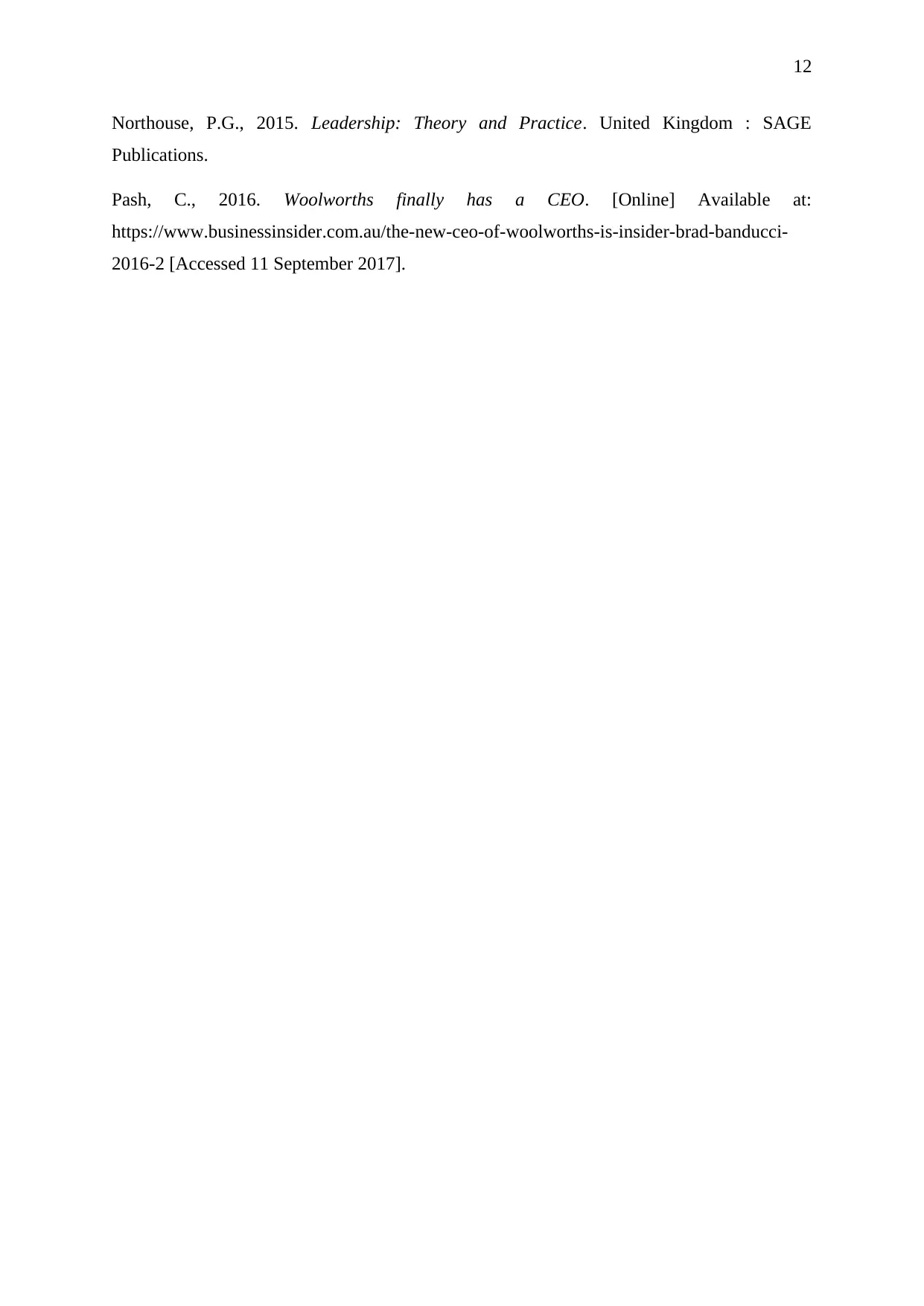
12
Northouse, P.G., 2015. Leadership: Theory and Practice. United Kingdom : SAGE
Publications.
Pash, C., 2016. Woolworths finally has a CEO. [Online] Available at:
https://www.businessinsider.com.au/the-new-ceo-of-woolworths-is-insider-brad-banducci-
2016-2 [Accessed 11 September 2017].
Northouse, P.G., 2015. Leadership: Theory and Practice. United Kingdom : SAGE
Publications.
Pash, C., 2016. Woolworths finally has a CEO. [Online] Available at:
https://www.businessinsider.com.au/the-new-ceo-of-woolworths-is-insider-brad-banducci-
2016-2 [Accessed 11 September 2017].
⊘ This is a preview!⊘
Do you want full access?
Subscribe today to unlock all pages.

Trusted by 1+ million students worldwide
1 out of 12
Related Documents
Your All-in-One AI-Powered Toolkit for Academic Success.
+13062052269
info@desklib.com
Available 24*7 on WhatsApp / Email
![[object Object]](/_next/static/media/star-bottom.7253800d.svg)
Unlock your academic potential
Copyright © 2020–2025 A2Z Services. All Rights Reserved. Developed and managed by ZUCOL.




